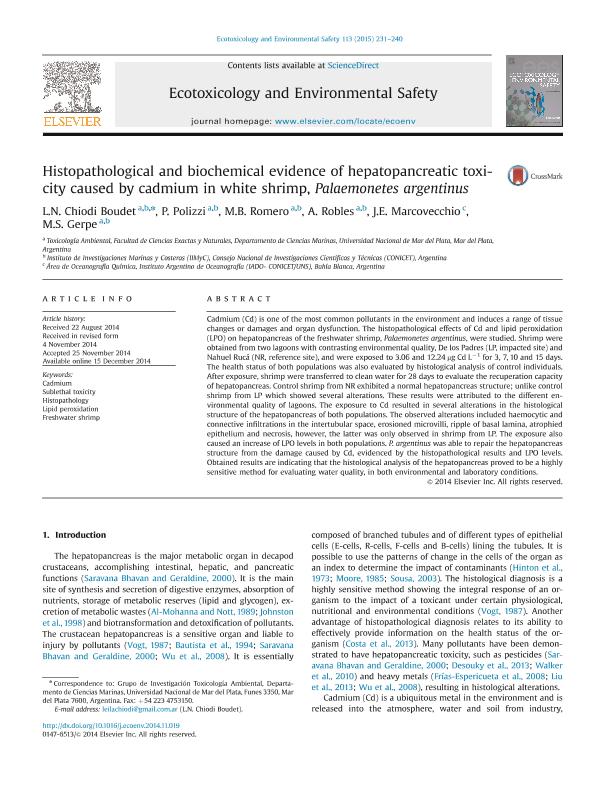Artículo
Histopathological biochemical evidence of hepatopancreatic toxicity caused by cadmium in white shrimp, Palaemonetes argentinus.
Chiodi Boudet, Leila Natalia ; Polizzi, Paula Sabrina
; Polizzi, Paula Sabrina ; Romero, María Belén
; Romero, María Belén ; Robles, Alicia Daniela
; Robles, Alicia Daniela ; Marcovecchio, Jorge Eduardo
; Marcovecchio, Jorge Eduardo ; Gerpe, Marcela Silvia
; Gerpe, Marcela Silvia
 ; Polizzi, Paula Sabrina
; Polizzi, Paula Sabrina ; Romero, María Belén
; Romero, María Belén ; Robles, Alicia Daniela
; Robles, Alicia Daniela ; Marcovecchio, Jorge Eduardo
; Marcovecchio, Jorge Eduardo ; Gerpe, Marcela Silvia
; Gerpe, Marcela Silvia
Fecha de publicación:
03/2015
Editorial:
Elsevier Inc
Revista:
Ecotoxicology and Environmental Safety
ISSN:
0147-6513
Idioma:
Inglés
Tipo de recurso:
Artículo publicado
Clasificación temática:
Resumen
Cadmium (Cd) is one of the most common pollutants in the environment and induces a range of tissue changes or damages and organ dysfunction. The histopathological effects of Cd and lipid peroxidation (LPO) on hepatopancreas of the freshwater shrimp, Palaemonetes argentinus, were studied. Shrimp were obtained from two lagoons with contrasting environmental quality, De los Padres (LP, impacted site) and Nahuel Rucá (NR, reference site), and were exposed to 3.06 and 12.24 µg Cd L−1 for 3, 7, 10 and 15 days. The health status of both populations was also evaluated by histological analysis of control individuals. After exposure, shrimp were transferred to clean water for 28 days to evaluate the recuperation capacity of hepatopancreas. Control shrimp from NR exhibited a normal hepatopancreas structure; unlike control shrimp from LP which showed several alterations. These results were attributed to the different environmental quality of lagoons. The exposure to Cd resulted in several alterations in the histological structure of the hepatopancreas of both populations. The observed alterations included haemocytic and connective infiltrations in the intertubular space, erosioned microvilli, ripple of basal lamina, atrophied epithelium and necrosis, however, the latter was only observed in shrimp from LP. The exposure also caused an increase of LPO levels in both populations. P. argentinus was able to repair the hepatopancreas structure from the damage caused by Cd, evidenced by the histopathological results and LPO levels. Obtained results are indicating that the histological analysis of the hepatopancreas proved to be a highly sensitive method for evaluating water quality, in both environmental and laboratory conditions.
Archivos asociados
Licencia
Identificadores
Colecciones
Articulos(IADO)
Articulos de INST.ARG.DE OCEANOGRAFIA (I)
Articulos de INST.ARG.DE OCEANOGRAFIA (I)
Citación
Chiodi Boudet, Leila Natalia; Polizzi, Paula Sabrina; Romero, María Belén; Robles, Alicia Daniela; Marcovecchio, Jorge Eduardo; et al.; Histopathological biochemical evidence of hepatopancreatic toxicity caused by cadmium in white shrimp, Palaemonetes argentinus.; Elsevier Inc; Ecotoxicology and Environmental Safety; 113; 3-2015; 231-240
Compartir



